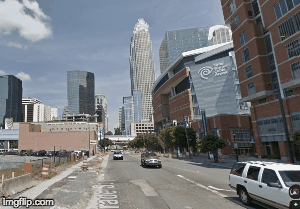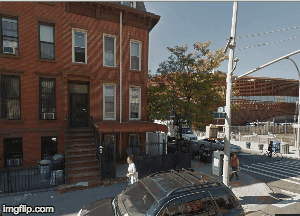Dirty secret behind Brooklyn's DNC 2016 bid: likely major impacts to area around Barclays Center, as Charlotte example suggests
As the Democratic National Committee deliberates among Brooklyn, Philadelphia, and Columbus for the 2016 DNC Convention, there's been a strong effort to portray elected officials and especially Brooklynites as united behind the bid--or, at least, quietly neutral.
That happens when political heavyweights--notably Mayor Bill de Blasio and Sen. Charles Schumer, both Brooklynites--drive a moving train. At a press conference/pep rally two weeks ago, Schumer airily dismissed any logistical concerns.
"We'll make sure that everything works out just fine," he said.
"When the Barclays Center was built, people said, Every time there's a Nets game, every time there's a concert, there will be bottlenecks. There isn't," Schumer insisted. "Everything is handled great. I live there, I know, I come home."
That's not quite true, and it's not quite relevant.
The DNC would be a very big deal, far more burdensome than officials let on.
For a suggestion of the burdens, consider the street closures in downtown Charlotte, where the 2012 DNC was held over three days. (Some street closures lasted five days, as noted in the document at bottom.)
The event attracted some 35,000 people, including delegates, journalists, and protesters. Officials set up three checkpoints lasting two days.
Yes, New York handled a Republican convention in 2004 at Madison Square Garden, with 10,000 cops and significant security strictures for those working near the arena, but I think the more recent Charlotte example may be more relevant to Brooklyn.
In Charlotte, not everything worked as planned. Mail service (including FedEx & UPS) was supposed to operate on a normal schedule. But about 1,400 Postal Service customers didn't get mail for three days, according to the Charlotte Observer.
Officials searched 10,000 vehicles in one day, with bomb-sniffing dogs. Three schools had early dismissals, while various governmental agencies were closed. Occasional road closures, such as for the president's motorcade, caused significant traffic problems.
Charlotte not residential like Brooklyn
Moreover, as shown in the GIFs here and maps below, the two arenas are cited in different zones. The Time Warner Arena in Charlotte is in a downtown zone with significant barriers like parking lots. See the GIF above right.
By contrast, the Barclays Center is placed more precariously, bordered by two major roads but also wedged into and near residential blocks, as shown in the GIF at left.
In Brooklyn, negotiate before knowing impact?
Some neighborhood groups around the arena, I hear, are working up wish lists, if de Blasio commits spending on infrastructure or local projects to offset the impact of this international event, complete with protesters and a serious security presence, in their backyard.
That may be a pragmatic strategy, given the dangers in challenging the mayor, but I'm not sure it's a wise one.
After all, we don't know the trade-off. It's clear the DNC would be good for de Blasio, and terrific for arena developer Forest City Ratner, which has its share of the building on the block. And it may be good for the borough and city.
But it would be particularly burdensome to arena neighbors. Just how much, we don't know. So until the city shares at least a preliminary plan, it's dangerous to negotiate.
After all, it's safe to say that it will be far worse than the mayor let on.
Remember, only after Politico reported on potential business closures near the arena did de Blasio acknowledge it. Business leader Kathleen Wylde told the Daily News that "neighbors and business owners will likely need to garage their private vehicles for the duration, and people will probably not be able to drive into the Atlantic Center" mall.
That means it surely will be more impactful. (Remember the MTV Video Music Awards, a relatively tiny event?)
Charlotte and Brooklyn settings: rough comparisons
Consider this crude comparison, screenshots from Google Earth. The rough outline of the Charlotte street closures is within this first screenshot, though the closures did not extend to all the streets.
Note the significant number of civic buildings, office buildings, and parking lots. Note that the 780,000 square foot arena is on a nine-acre parcel, a significant larger one than the 670,000 sf Barclays Center.
Now consider a larger but relatively similar zone--just a guess, but a reasonable and perhaps even conservative one--in Brooklyn. This suggests street closures likely will include parts of Flatbush and Atlantic avenues, and maybe even Fourth Avenue and Fulton Street.
I've extended this map to a longer distance, because I think the entire Atlantic Yards site, to Vanderbilt Avenue, would be affected.
Doesn't this need more disclosure before cheerleading and horse-trading?
The preparations in Charlotte
Note the press release (below) from city, state, and federal officials, and scroll down for maps regarding streets closed to vehicles and pedestrians.
That wasn't the whole story. As the Charlotte Observer reported, federal officials said, “Temporary security restrictions not previously identified may be necessary and may not be announced in advance.” Indeed, as noted above, mail service stopped.
That happens when political heavyweights--notably Mayor Bill de Blasio and Sen. Charles Schumer, both Brooklynites--drive a moving train. At a press conference/pep rally two weeks ago, Schumer airily dismissed any logistical concerns.
 |
| Street closures in downtown Charlotte, via Charlotte Observer |
"When the Barclays Center was built, people said, Every time there's a Nets game, every time there's a concert, there will be bottlenecks. There isn't," Schumer insisted. "Everything is handled great. I live there, I know, I come home."
That's not quite true, and it's not quite relevant.
The DNC would be a very big deal, far more burdensome than officials let on.
For a suggestion of the burdens, consider the street closures in downtown Charlotte, where the 2012 DNC was held over three days. (Some street closures lasted five days, as noted in the document at bottom.)
The event attracted some 35,000 people, including delegates, journalists, and protesters. Officials set up three checkpoints lasting two days.
Yes, New York handled a Republican convention in 2004 at Madison Square Garden, with 10,000 cops and significant security strictures for those working near the arena, but I think the more recent Charlotte example may be more relevant to Brooklyn.
 |
| Around the Charlotte arena |
Officials searched 10,000 vehicles in one day, with bomb-sniffing dogs. Three schools had early dismissals, while various governmental agencies were closed. Occasional road closures, such as for the president's motorcade, caused significant traffic problems.
Charlotte not residential like Brooklyn
Moreover, as shown in the GIFs here and maps below, the two arenas are cited in different zones. The Time Warner Arena in Charlotte is in a downtown zone with significant barriers like parking lots. See the GIF above right.
 |
| Around the Brooklyn arena |
In Brooklyn, negotiate before knowing impact?
Some neighborhood groups around the arena, I hear, are working up wish lists, if de Blasio commits spending on infrastructure or local projects to offset the impact of this international event, complete with protesters and a serious security presence, in their backyard.
That may be a pragmatic strategy, given the dangers in challenging the mayor, but I'm not sure it's a wise one.
After all, we don't know the trade-off. It's clear the DNC would be good for de Blasio, and terrific for arena developer Forest City Ratner, which has its share of the building on the block. And it may be good for the borough and city.
But it would be particularly burdensome to arena neighbors. Just how much, we don't know. So until the city shares at least a preliminary plan, it's dangerous to negotiate.
After all, it's safe to say that it will be far worse than the mayor let on.
Remember, only after Politico reported on potential business closures near the arena did de Blasio acknowledge it. Business leader Kathleen Wylde told the Daily News that "neighbors and business owners will likely need to garage their private vehicles for the duration, and people will probably not be able to drive into the Atlantic Center" mall.
That means it surely will be more impactful. (Remember the MTV Video Music Awards, a relatively tiny event?)
Charlotte and Brooklyn settings: rough comparisons
Consider this crude comparison, screenshots from Google Earth. The rough outline of the Charlotte street closures is within this first screenshot, though the closures did not extend to all the streets.
 |
| Arena neighborhood, Charlotte |
Now consider a larger but relatively similar zone--just a guess, but a reasonable and perhaps even conservative one--in Brooklyn. This suggests street closures likely will include parts of Flatbush and Atlantic avenues, and maybe even Fourth Avenue and Fulton Street.
 |
| Arena neighborhood, Brooklyn |
Doesn't this need more disclosure before cheerleading and horse-trading?
The preparations in Charlotte
Note the press release (below) from city, state, and federal officials, and scroll down for maps regarding streets closed to vehicles and pedestrians.
That wasn't the whole story. As the Charlotte Observer reported, federal officials said, “Temporary security restrictions not previously identified may be necessary and may not be announced in advance.” Indeed, as noted above, mail service stopped.
Comments
Post a Comment